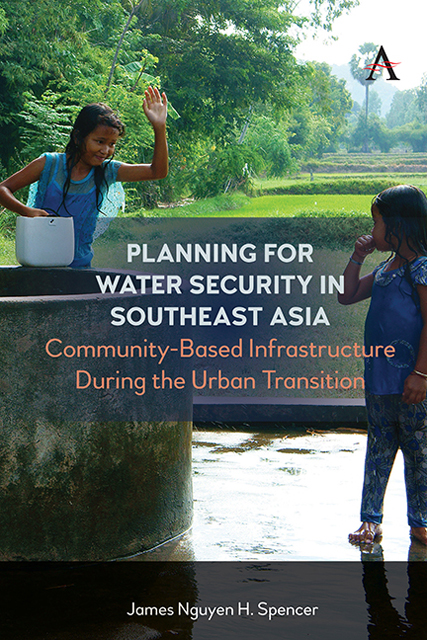 Planning for Water Security in Southeast Asia
Planning for Water Security in Southeast Asia Book contents
- Frontmatter
- Content
- Preface
- Introduction
- 1 Water and Human Security
- 2 Global Urbanization: The Confluence of Peri-Urbanization and Urban Transition
- 3 Community-Based Public Finance of Deep Well Water Systems in Peri-Urban Java
- 4 The Peri-Urbanization of Can Tho and the rise of Entrepreneurial Water Suppliers in the Mekong Delta
- 5 Ha Noi: Bulk Water Retailing in Peri-Urban Areas
- 6 Peri-Urbanization, Co-Production and Institutional Culture: The Case of the Phnom Penh Water Supply Authority
- 7 Beyond Resilience: Are we thinking about Entitlements, Participation and Governance in the Right Way?
- References
- Index
5 - Ha Noi: Bulk Water Retailing in Peri-Urban Areas
Published online by Cambridge University Press: 10 January 2023
- Frontmatter
- Content
- Preface
- Introduction
- 1 Water and Human Security
- 2 Global Urbanization: The Confluence of Peri-Urbanization and Urban Transition
- 3 Community-Based Public Finance of Deep Well Water Systems in Peri-Urban Java
- 4 The Peri-Urbanization of Can Tho and the rise of Entrepreneurial Water Suppliers in the Mekong Delta
- 5 Ha Noi: Bulk Water Retailing in Peri-Urban Areas
- 6 Peri-Urbanization, Co-Production and Institutional Culture: The Case of the Phnom Penh Water Supply Authority
- 7 Beyond Resilience: Are we thinking about Entitlements, Participation and Governance in the Right Way?
- References
- Index
Summary
Can Tho is a rapidly growing city in a heavily agricultural region and resembles a provincial town more than an urban mega region. Ha Noi, however, has grown at a similar rapid rate but from a much larger base and consequently shows a different kind of adaptation to the high demands for urban water supplies.
The city of Ha Noi has grown rapidly since the beginning of market reforms in the late 1980s in Viet Nam, and the city has begun to incorporate new peri-urban areas without basic urban services. In Tu Liem District's Co Nhue Ward, a neighborhood located in the peri-urban area of Ha Noi, people paid a higher water tariff than the standard citywide one, which had been regulated by the Ha Noi People's Committee. Although supplying piped water for Co Nhue commune residents since 1997, the Ha Noi Water Business Company (HWBC) did not directly manage the piped-water network in the commune, which was built by the Ha Noi Department of Public Works and Transportation. Instead, the company developed a lease contract with the Co Nhue People's Committee (CPC) and provided water in bulk to the com-mune's piped network through a master water meter. The local CPC then established a local water supply management unit (WMU) to retail water to domestic household users. While initially functional, eventually the local water retailer became overwhelmed by the increasing demands and needed to be taken over by the larger HWBC. This case represents a local, ward-level government playing an entrepreneurial, yet temporarily useful, role between the larger municipal utility and local residents.
Co Nhue Commune in Peri-Urbanizing Ha Noi
Situated in an area of approximately 615 hectares, 10 miles away from the center of the capital Hanoi, Co Nhue commune became a unit of administration of Tu Liem district, a western rural district of Hanoi, in 1961 (Pham et al., 1994). According to historical archives and documents kept in the local temple, shrines, and the Communal House, Co Nhue village, a unit of settlement of wet paddy cultivators, was established more than a thousand years ago. Like other traditional villages in the delta of the Red River, Co Nhue was constructed on elevated ground near the Nhuệ River, so that the villagers could easily access water for daily life and irrigation purposes, which was essential for wet rice cultivation.
- Type
- Chapter
- Information
- Planning for Water Security in Southeast AsiaCommunity-Based Infrastructure During the Urban Transition, pp. 127 - 158Publisher: Anthem PressPrint publication year: 2022
